
Central Bank of Ceylon
King George VI - 1951
Currency Notes printed with date 1951-01-20 and issued in 1952 April
by the Central Bank of Ceylon with the portrait of His Majesty
King George VI.
Although Ceylon got independence on 1948 February 4th the
British Monarch remained head of State till the Republican Constitution of 1972.
Born on 1895 December 14th, Prince George, ascended to
the throne on 1936 December 11th, on abdication of his brother King Edward VIII.
George VI, and was coronated on 1937 May 12th.
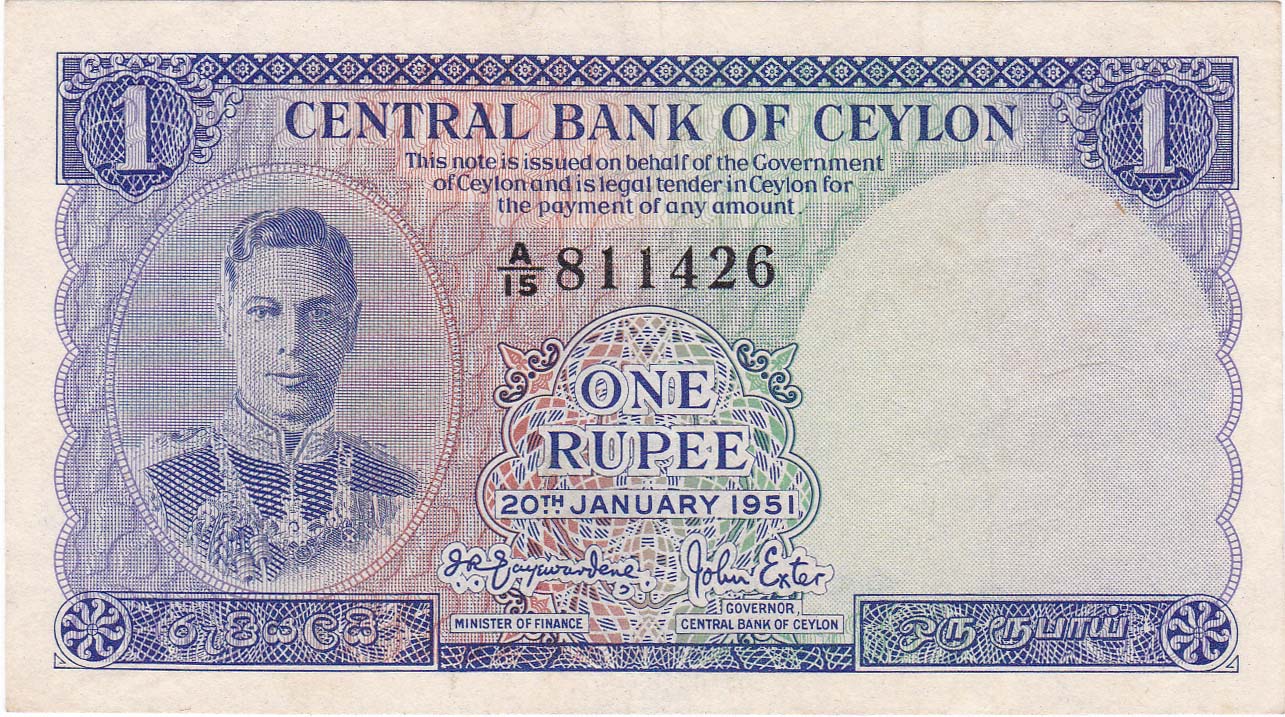
| 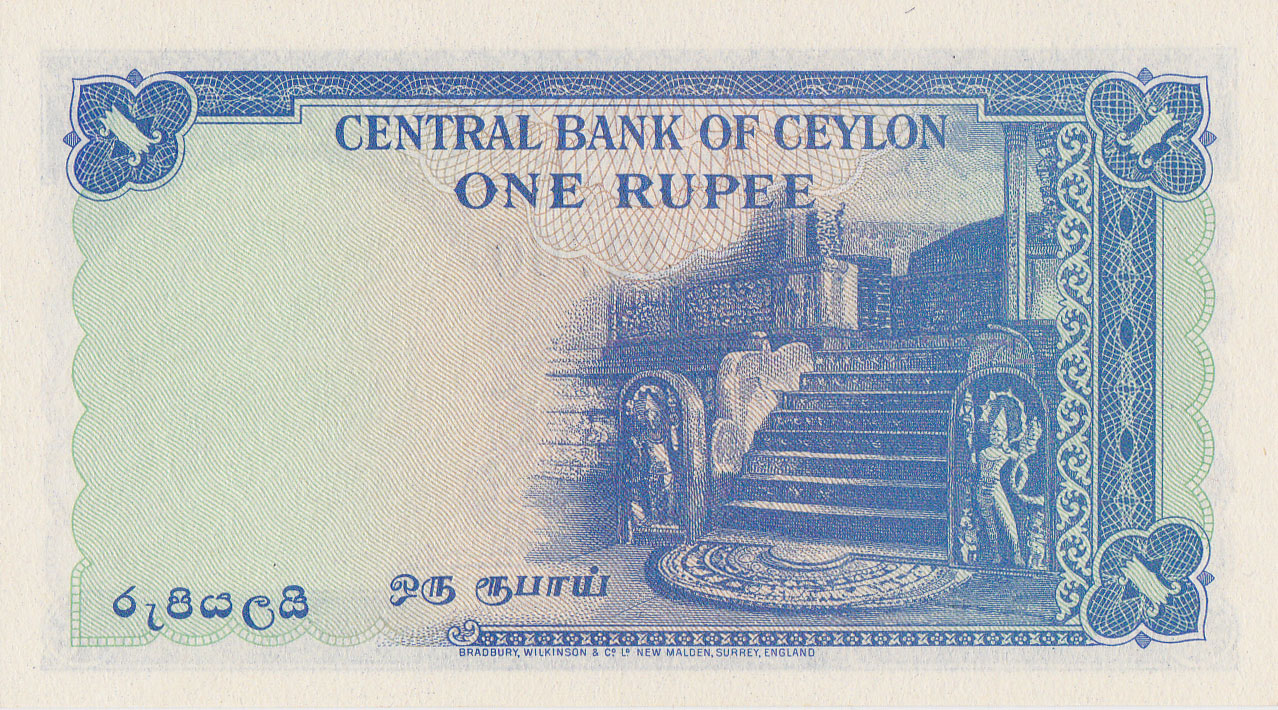
|
| Denomination | : 1 Rupee |
Base Color | : Blue |
| Under-print | : Orange & Green |
English | : One Rupee |
| Sinhala | : රුපියලයි |
Thamil | : ஒரு ரூபாய் |
| Size | : 108 x 60 mm |
SCWPM-lk | : 47 |
| Back Pictorial : | Moonstone and ornate stone
stairway to Vatadage in medieval City of Polonnaruwa, Sri Lanka.
|
|
| Deno. | Date on Note | Minister of Finance | Governor CBC | 1st Serial # | 000 Pcs |
| Re.1 | 20TH JANUARY 1951 | J.R.Jayawardena | John Exter | A/1 000001 | 30,000 |
|
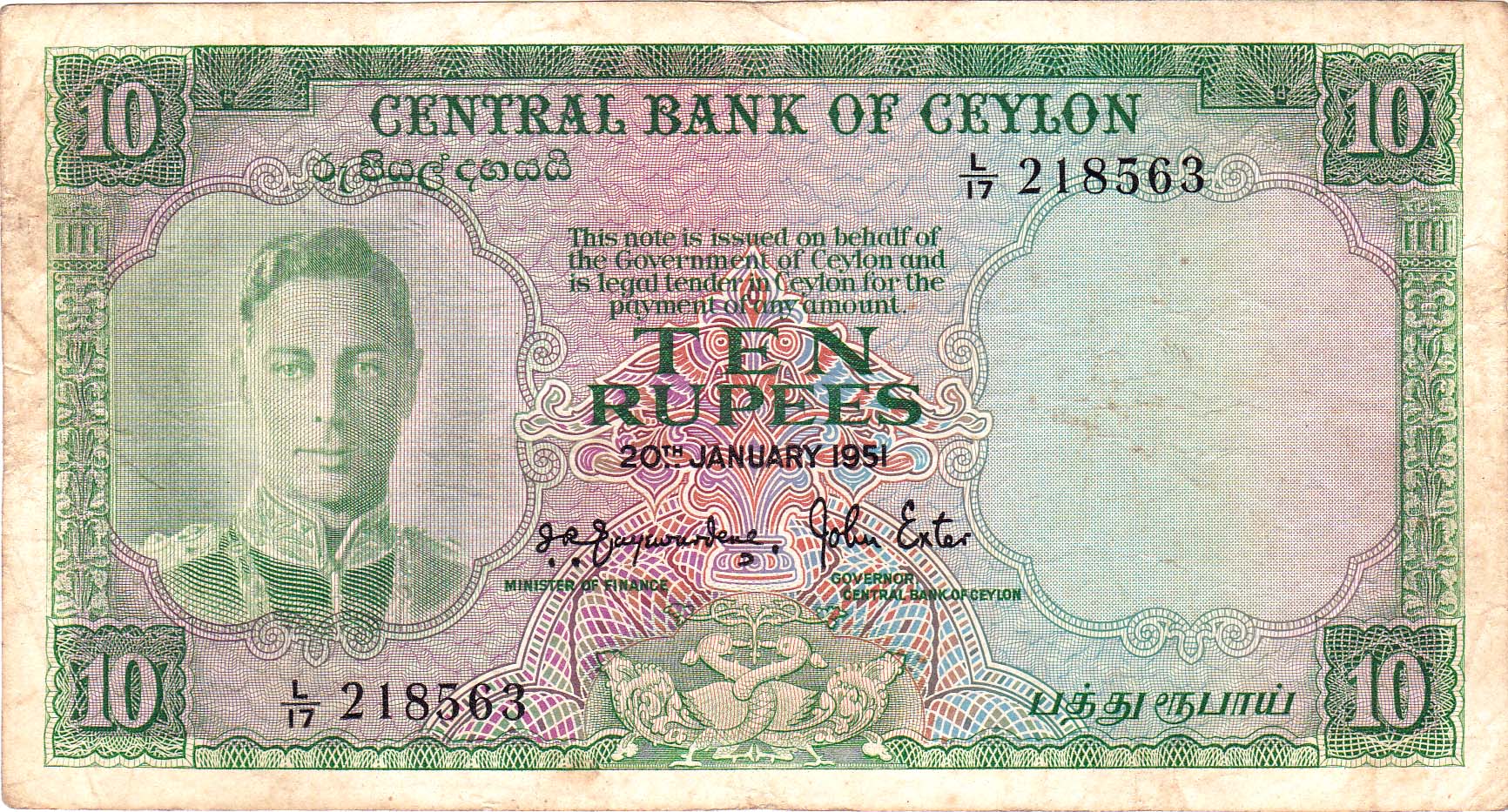
| 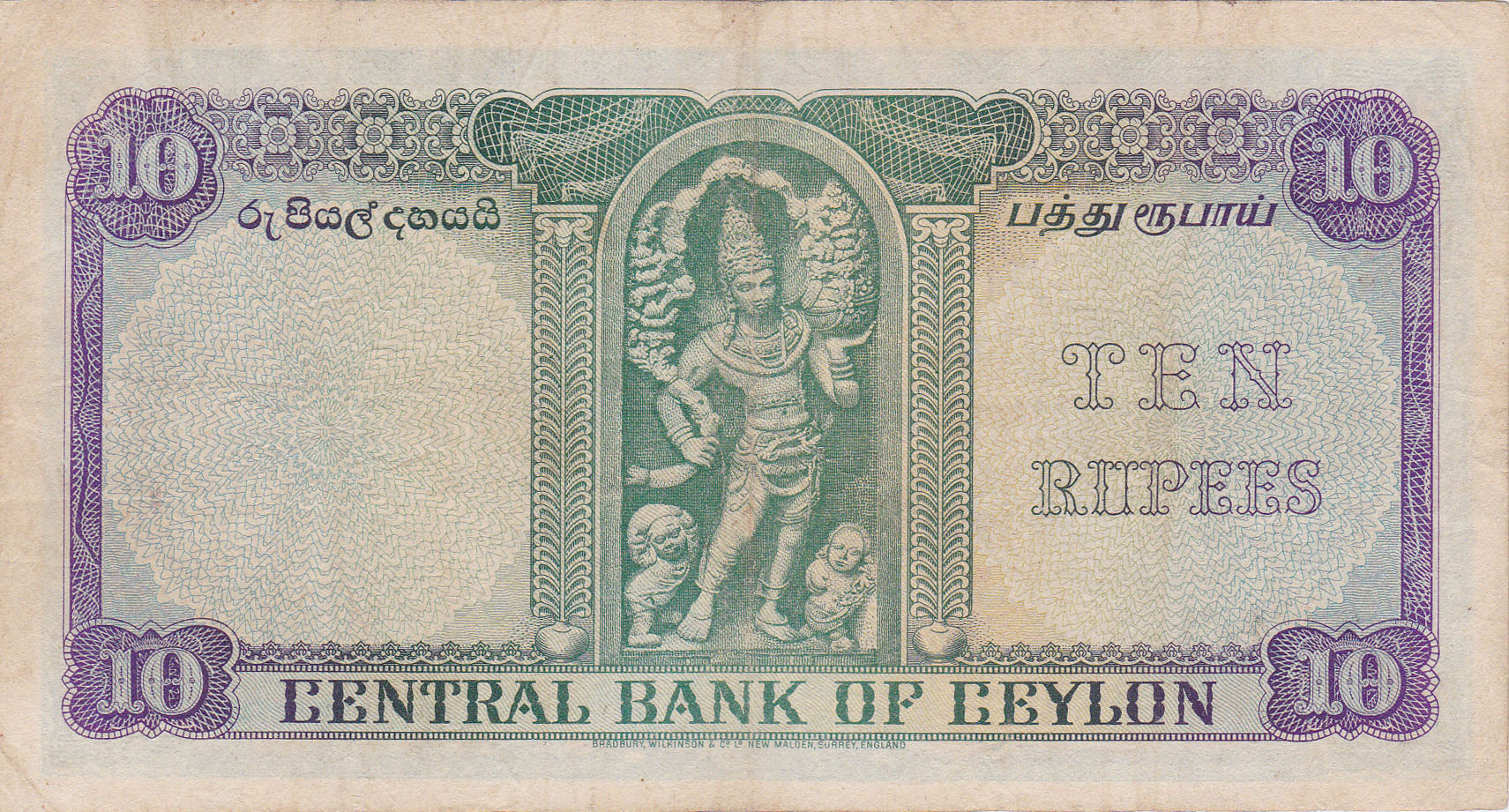
|
| Denomination | : 10 Rupees |
Base Color | : Green |
| Under-print | : Violet, Brown & Blue |
English | : Ten Rupees |
| Sinhala | : රුපියල් දහයයි
| Thamil | : பத்து ரூபாய் |
| Size | : 146x 79 mm |
SCWPM-lk | : 48 |
| Back Pictorial : | Guard standing with pot of
plenty (punkalasa) in his left hand and in the other a
sprouting branch complete with leaves, buds and flowers. A
pair of midgets (Bahirawa) at on either side of his feet.
|
|
| Deno. | Date on Note | Minister of Finance | Governor CBC | 1st Serial # | 000 Pcs |
tr> Rs.10 | 20TH JANUARY 1951 | J.R.Jayawardena | John Exter | L/1 000001 | 20,000 |
|
Front: Portrait of His Majesty King George VI facing
forward, within panel on left. Similer panel for water-mark on the
right. CENTRAL BANK OF CEYLON at upper centre above
This note is issued on behalf of the Government of Ceylon and is
legal tender in Ceylon for the payment of any amount in three
or four lines. The Value RUPEES in two lines in
English at center. The date as Day Month Year below. Facsimile
English signatures above MINISTER OF FINANCE on
left and GOVERNOR CENTRAL BANK OF CEYLON on
right. One Serial No at center for Re 1 and twice on lower
left and upper right for Rupees 10. Value in Sinhala
රුපියල්
on left, at top or bottom and value in Thamil
ரூபாய்
on right always at bottom. All within a rectangular decorated border
with Numeric Value in upper two corners and both or none of
lower corners.
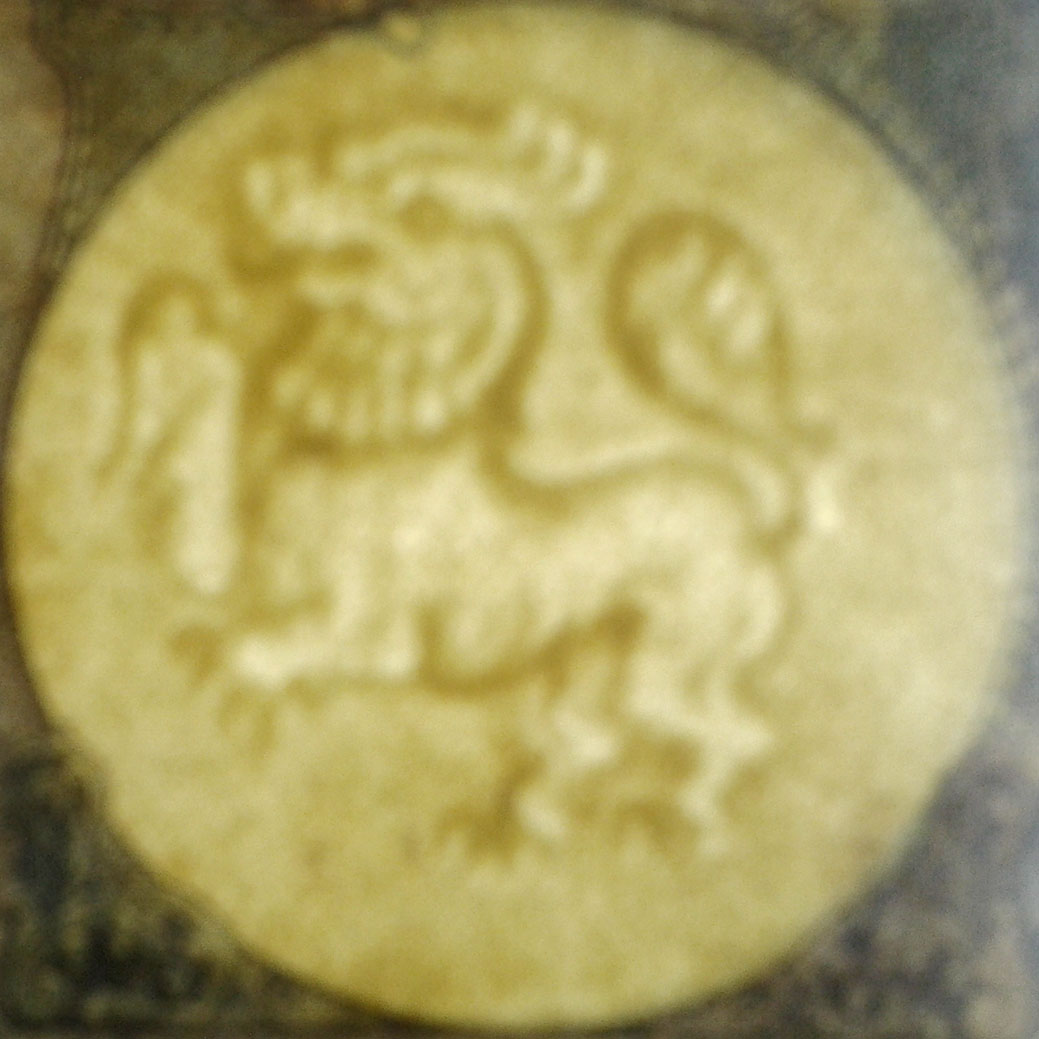 Back: Rectangular decorated border with Numeric Value in upper
two corners and both or right of lower corners. Centered in
border CENTRAL BANK OF CEYLON on top or bottom. In English
Text, Value RUPEES at Upper or right. Within border,
Top or Bottom, value in Sinhala
රුපියල්
on left, and value in Thamil
ரூபாய்
on right, Top or Bottom.
Back: Rectangular decorated border with Numeric Value in upper
two corners and both or right of lower corners. Centered in
border CENTRAL BANK OF CEYLON on top or bottom. In English
Text, Value RUPEES at Upper or right. Within border,
Top or Bottom, value in Sinhala
රුපියල්
on left, and value in Thamil
ரூபாய்
on right, Top or Bottom.
Ceylon Pictorial on right or centered on micro under-print pattern
with colored shading.
At bottom centered just below horizontal decorate in small script
BRADBURY WILKINSON & CO LD NEW MALDEN. SURREY, ENGLAND.
Watermark: Lion standing on hind legs facing left with
bent whip in right paw, Lion Lighter with outline including whip darker than paper.
Although the general layout of all the notes are similer, the shape
and location of each of the elements are slightly different for each
of the denominations.
| Denomination | Re 1 | Rs 10
|
| Portrait Panel | Oval | Scallop
|
| Legality lines | 3 | 4
|
| Eng. Value lines | 2 | 2
|
| Front Lower Numbers | None | Both
|
| Back Lower Numbers | Right | Both
|
| Back Eng. CBC Center | Top | Bottom
|
| Front Sinhala Left | Bottom | Top
|
| Front Thamil Right | Bottom | Bottom
|
| Back English Center | Upper | Right
|
| Back Sinhala Left | Bottom | Top
|
| Back Thamil | BotCen | TopRig
|
| Back Pictorial | Right | Center
|
| Minister of Finance | Governor
Central Bank of Ceylon |
20TH JANUARY 1951
 |
| J.R.Jayawardena | John Exter |
|
Only these two denominations, with this date were issued into circulations as King George VI
passed away on 1952 February 6th.
Proof Specimens are known for other denominations, but they were never issued to Public.
The classic Dorothy Wilding
photograph of
His Majesty King George VI,
hangs in National Portrait Gallery in London, UK.
The Central Bank of Ceylon Annual Report for 1952 says I quote
98. During 1952 the Central Bank issued for the first time currency
notes designed and printed under its authority. The new notes were in
denominations of Rs. 10, Rs. 2, and Re. 1.
The currency in circulation for 1952 shows an increase in Circulation
of Both the Rs 10 and Re 10. notes in 1952 April and may have been the
month of issue. (Need to check Newspapers). New Notes are issued
tradinionally for Sinhala & Tamil New Year.
The notes were scanned at 300 dpi and displayed at 50 dpi.





 Back: Rectangular decorated border with Numeric Value in upper
two corners and both or right of lower corners. Centered in
border CENTRAL BANK OF CEYLON on top or bottom. In English
Text, Value RUPEES at Upper or right. Within border,
Top or Bottom, value in Sinhala
Back: Rectangular decorated border with Numeric Value in upper
two corners and both or right of lower corners. Centered in
border CENTRAL BANK OF CEYLON on top or bottom. In English
Text, Value RUPEES at Upper or right. Within border,
Top or Bottom, value in Sinhala
